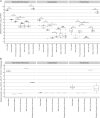Impact of Poultry Processing Operating Parameters on Bacterial Transmission and Persistence on Chicken Carcasses and Their Shelf Life
- PMID: 32276979
- PMCID: PMC7267199
- DOI: 10.1128/AEM.00594-20
Impact of Poultry Processing Operating Parameters on Bacterial Transmission and Persistence on Chicken Carcasses and Their Shelf Life
Abstract
It is important for the poultry industry to maximize product safety and quality by understanding the connection between bacterial diversity on chicken carcasses throughout poultry processing to the end of shelf life and the impact of the local processing environment. Enumeration of total aerobic bacteria, Campylobacter and Pseudomonas, and 16S rRNA gene amplicon sequencing were used to evaluate the processing line by collecting 10 carcasses from five processing steps: prescald, postplucker, pre- and post-immersion chill, and post-air chill. The diversity throughout a 12-day shelf life was also determined by examining 30 packaged carcasses. To identify the sources of possible contamination, scald water tank, immersion chilling water tank, air samples, and wall surfaces in the air-chill room were analyzed. Despite bacterial reductions on carcasses (>5 log10 CFU/ml) throughout the process, each step altered the bacterial diversity. Campylobacter was a minor but persistent component in the bacterial community on carcasses. The combination of scalding, defeathering, and plucking distributed thermophilic spore-forming Anoxybacillus to carcasses, which remained at a high abundance on carcasses throughout subsequent processes. Pseudomonas was not isolated from carcasses after air chilling but was abundant on the wall of the air-chill room and became the predominant taxon at the end of shelf life, suggesting possible contamination through air movement. The results suggest that attention is needed at each processing step, regardless of bacterial reductions on carcasses. Changing scalding water regularly, maintaining good hygiene practices during processing, and thorough disinfection at the end of each processing day are important to minimize bacterial transmission.IMPORTANCE Culture-based and culture-independent approaches were utilized to reveal bacterial community changes on chicken carcasses at different processing steps and potential routes from the local processing environment. Current commercial processing effectively reduced bacterial loads on carcasses. Poultry processes have similar processes across facilities, but various processing arrangements and operating parameters could impact the bacterial transmission and persistence on carcasses differently. This study showed the use of a single tunnel incorporating scalding, defeathering and plucking may undesirably distribute the thermoduric bacteria, e.g., Campylobacter and Anoxybacillus, between the local environment and carcasses, whereas this does not occur when these steps are separated. The length of immersion and air chilling also impacted bacterial diversity on carcasses. Air chilling can transfer Pseudomonas from wall surfaces onto carcasses; this may subsequently influence chicken product shelf life. This study helps poultry processors understand the impact of current commercial processing and improve the chicken product quality and safety.
Keywords: 16S rRNA; Anoxybacillus; Campylobacter; Pseudomonas; bacterial diversity; environment; food safety; microbiome; poultry processing; shelf life.
© Crown copyright 2020.
Figures






Similar articles
-
Changes of the bacterial community diversity on chicken carcasses through an Australian poultry processing line.Food Microbiol. 2020 Apr;86:103350. doi: 10.1016/j.fm.2019.103350. Epub 2019 Oct 21. Food Microbiol. 2020. PMID: 31703868
-
Exposure assessment and process sensitivity analysis of the contamination of Campylobacter in poultry products.Poult Sci. 2011 Jul;90(7):1562-73. doi: 10.3382/ps.2009-00577. Poult Sci. 2011. PMID: 21673173
-
Contamination of yellow-feathered broiler carcasses: Microbial diversity and succession during processing.Food Microbiol. 2019 Oct;83:18-26. doi: 10.1016/j.fm.2019.04.006. Epub 2019 Apr 20. Food Microbiol. 2019. PMID: 31202410
-
A comparison of fluctuations of Campylobacter and Escherichia coli concentrations on broiler chicken carcasses during processing in two slaughterhouses.Int J Food Microbiol. 2015 Jul 16;205:119-27. doi: 10.1016/j.ijfoodmicro.2015.04.006. Epub 2015 Apr 10. Int J Food Microbiol. 2015. PMID: 25950748
-
Interventions to reduce Salmonella and Campylobacter during chilling and post-chilling stages of poultry processing: a systematic review and meta-analysis.Poult Sci. 2024 Apr;103(4):103492. doi: 10.1016/j.psj.2024.103492. Epub 2024 Jan 24. Poult Sci. 2024. PMID: 38335673 Free PMC article.
Cited by
-
The Microbiome Characterization of Edible Visceral Organs and Fresh Meat During Production in a Pig Processing Facility in Thailand.Pathogens. 2025 May 14;14(5):475. doi: 10.3390/pathogens14050475. Pathogens. 2025. PMID: 40430796 Free PMC article.
-
Prevention and Control of Human Salmonella enterica Infections: An Implication in Food Safety.Int J Food Sci. 2023 Sep 11;2023:8899596. doi: 10.1155/2023/8899596. eCollection 2023. Int J Food Sci. 2023. PMID: 37727836 Free PMC article. Review.
-
Detection of Extended-Spectrum β-Lactamase (ESBL) E. coli at Different Processing Stages in Three Broiler Abattoirs.Microorganisms. 2023 Oct 12;11(10):2541. doi: 10.3390/microorganisms11102541. Microorganisms. 2023. PMID: 37894199 Free PMC article.
-
Improving quality of poultry and its meat products with probiotics, prebiotics, and phytoextracts.Poult Sci. 2024 Feb;103(2):103287. doi: 10.1016/j.psj.2023.103287. Epub 2023 Nov 22. Poult Sci. 2024. PMID: 38104412 Free PMC article. Review.
-
Shifts in surface microbiota after cleaning and disinfection in broiler processing plants: incomplete biofilm eradication revealed by robotic high-throughput screening.Appl Environ Microbiol. 2025 Mar 19;91(3):e0240124. doi: 10.1128/aem.02401-24. Epub 2025 Feb 26. Appl Environ Microbiol. 2025. PMID: 40008875 Free PMC article.
References
-
- ABARES. 2017. Agricultural commodity statistics, 2017. Australian Bureau of Agricultural and Resource Economics, Canberra, Australia: http://data.daff.gov.au/data/warehouse/agcstd9abcc002/agcstd9abcc0022017....
-
- WHO. 2015. WHO estimates of the global burden of foodborne diseases In Foodborne disease burden epidemiology reference group, 2007–2015. World Health Organization, Geneva, Switzerland.
-
- Marder EP, Cieslak PR, Cronquist AB, Dunn J, Lathrop S, Rabatsky-Ehr T, Ryan P, Smith K, Tobin-D’Angelo M, Vugia DJ, Zansky S, Holt KG, Wolpert BJ, Lynch M, Tauxe R, Geissler AL. 2017. Incidence and trends of infections with pathogens transmitted commonly through food and the effect of increasing use of culture-independent diagnostic tests on surveillance: Foodborne Diseases Active Surveillance Network, 10 U.S. sites, 2013–2016. Centers for Disease Control and Prevention, Atlanta, GA. - PMC - PubMed
Publication types
MeSH terms
LinkOut - more resources
Full Text Sources

